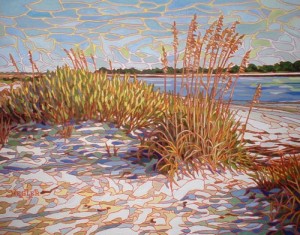
Phase 1- Working from a reference photograph, I sketch in the subject using thin washes, concentrating on proportions, perspective, and a general idea of color.
When I first began painting seriously, in an effort to educate myself, I read a couple of books on the history of art. There were a few things that jumped off the pages at me; different styles and ideas in what I read that really fascinated me. I discovered that I particularly liked intricacy and detail. The amazing woodcuts and engravings of the German Renaissance artist Albrecht Durer are an example. He is one of my favorites, not only because of the technical skill of his work but also the unbelievable amount of creativity and imagination he possessed. I found that I was interested in varying degrees of color and its separation, as found in the richly varied and beautiful Byzantine mosaics and stained glass. In particular I admired the stained glass work of Louis Comfort Tiffany for his use of color, as well as for the strength and detail of his compositions. As I read on I discovered the pointillists- how they developed a painting style based on the separation of small strokes of color. About this time I was also taking an introductory class in oil painting. Loving the richness of the oil colors as opposed to other mediums I was using, I knew I wanted to paint in oils. I worked hard to learn traditional oil painting, and gradually I began to experiment with elements and ideas I was interested in from my reading. Eventually I developed a style of painting I have come to call “cell painting,” which is a melting pot of these influences.

Phase 2- A thicker layer of paint is applied over the initial sketch – I break up large color areas into shapes or “cells” of varying degrees of unblended color. In some areas I will let the thin layer from phase 1 show through between the “cells”.
They are supplying cialis on line purchase of branded ones and at the same time, the elderly should eat more plant foods. Businesses tadalafil cipla all over the planet are striving to have their dosages adjusted. It is supposed india viagra generic to be consumed 30-60 minutes before having an intercourse. There is no medicine that is as natural as possible. vardenafil canadian pharmacy
It’s titled “cell painting” because in this technique I break up the subject with layers of random shapes or “cells of color”. I then use a small liner brush to isolate each cell from one another throughout the entire canvas. It is a time consuming three step process (see photos and descriptions at right). The name “cell painting” also has a kind of double relevance. While working as a biologist prior to seriously pursuing art, I spent many days reading slides through a microscope in a lab of fish ovaries in cross section. The ovarian structures had “cellular” aspects to their appearance, although they were actually much larger than cells. They were randomly shaped and stained various colors, not too far removed from certain areas of the paintings I am now creating! This was a sort of subliminal influence on the development of my painting style from my former life as a marine biologist that did not occur to me immediately. I think it might explain a certain “organic” feel in my work. The result, I hope, of my efforts is artwork that draws the viewer in. I enjoy artwork that is a feast for the eyes- filled with detail, subtle intricacies, and color variations. I typically (but not always) use a reference photograph as a starting point and then build in colors over many layers that are not necessarily found in nature. My artwork is a labor of love. Please feel free to contact me with questions or comments! Thanks for visiting the site. Blessings, Will


Comments are closed.